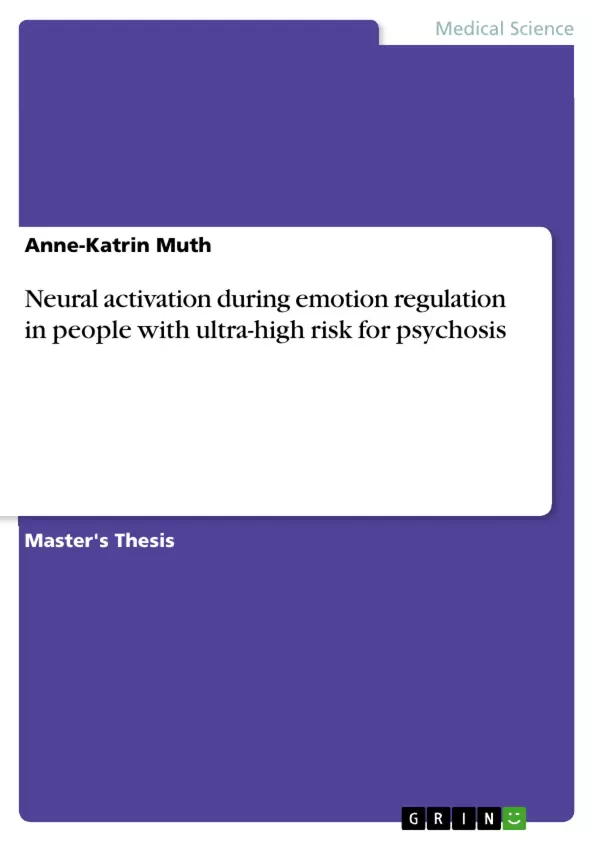Disturbances in emotion processing and regulation are a hallmark characteristic of schizophrenia, and have been shown to be present in at-risk populations. We investigated behavioral and functional Magnetic Resonance Imaging (fMRI) differences during emotion processing and reappraisal of negative images in people at ultra-high risk (UHR) for psychosis compared to healthy controls (HC).
We hypothesized that during emotion processing UHR participants will show increased activation of the ventral stream compared to HC. During reappraisal UHR were expected to show less activation of the dorsal stream compared to HC. Twelve UHR and eleven HC participated in this fMRI study in which they performed an Emotion Regulation Task. In addition, participants were asked to complete several relevant questionnaires.
Brain activation during processing of negative versus neutral images did not yield significant differences between the UHR and HC, but showed a trend for increased activation in UHR participants: HC showed activation in the middle and inferior temporal gyrus, whereas the UHR group showed activation in the bilateral DLPPFC, and bilateral frontopolar cortex, the superior and inferior occipital gyrus, the cingulate gyrus, the insula and the basal ganglia. During reappraisal differences in brain activation supported our hypothesis: the UHR group showed decreased prefrontal and temporal lobe activation compared to HC.
Results from the behavioral data showed that both groups were able to successfully down-regulate negative emotion. We concluded that the at-risk group showed abnormal brain activity during reappraisal that was in line with expectations, however the outcome of the behavioral results remains puzzling, and should be subjected to further study.
Inhaltsverzeichnis (Table of Contents)
- Introduction
- Emotion Processing
- Emotion Regulation
- Reappraisal
Zielsetzung und Themenschwerpunkte (Objectives and Key Themes)
This study aims to explore the differences in emotion processing and regulation in individuals at ultra-high risk (UHR) for psychosis compared to healthy controls (HC). The research utilizes functional Magnetic Resonance Imaging (fMRI) to investigate brain activation patterns during emotion processing and reappraisal tasks.
- Disturbances in emotion processing and regulation in schizophrenia and at-risk populations.
- Neural activation patterns associated with emotion processing and reappraisal in UHR individuals.
- The role of reappraisal as an emotion regulation strategy.
- The relationship between emotion regulation and social functioning.
- The potential for brain activity patterns to predict transition to psychosis.
Zusammenfassung der Kapitel (Chapter Summaries)
The introduction provides a background on schizophrenia and its prodromal phase, highlighting the importance of early intervention. It emphasizes the significant impact of emotional dysfunctions on individuals with schizophrenia, affecting their social, educational, and occupational lives.
The chapter on emotion processing discusses the hallmark characteristics of schizophrenia, including hypersensitivity to emotional events and reduced overt expression of emotion. It explores the concept of alexithymia and its connection to emotional processing difficulties. The chapter highlights the link between abnormal emotion processing, social cognition, and executive functions, suggesting their role in various symptoms of schizophrenia.
The section on emotion regulation defines the concept and distinguishes between antecedent-focused and response-focused strategies. It emphasizes the importance of reappraisal as a cost-efficient antecedent-focused strategy used in everyday life. The chapter explores the benefits of reappraisal and its potential impact on social interaction and personal well-being.
Schlüsselwörter (Keywords)
The study focuses on the key areas of schizophrenia, at-risk populations, emotion processing, reappraisal, and functional Magnetic Resonance Imaging (fMRI). It delves into the neurobiological mechanisms underlying emotion regulation in individuals at ultra-high risk for psychosis.
- Quote paper
- Anne-Katrin Muth (Author), 2012, Neural activation during emotion regulation in people with ultra-high risk for psychosis, Munich, GRIN Verlag, https://www.grin.com/document/461277



